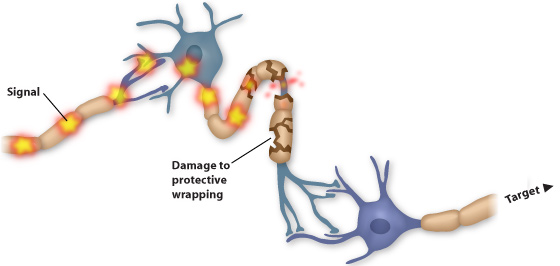LearnWhat is MS?
Multiple Sclerosis (MS) is a neurological condition that effects the central nervous system - the brain, spinal cord and optic nerve. It causes a wide range of symptoms including problems with muscle movement, balance and vision leading to diverse and varying degrees of disability.
MS is often difficult to initially diagnose but it is most commonly found in people aged 20 to 40. However, it can happen at any age. Further for reason as yet unknown, MS is three time more likely to effect women than men.
Currently there is no database showing how many people are affected by MS however very conservative figures show that around 1 in 600 people in the UK have the condition.
We estimate there are approximately 100,000 people with MS in the UK. And that each year 5,000 people are newly diagnosed with the condition.MS Society
The central nervous system
To understand what happens in MS, it’s useful to understand how the central nervous system works.
The central nervous system, consisting of the brain and the spinal cord, coordinates and controls most functions of the body and mind. The brain controls the majority of the body's functions whether it is movement, thought, memory, emotion or perception. The spinal cord is the information super highway, sending messages back and forth between the brain and the body.
These messages are sent through nerve fibres that use chemical and electrical signals to pass the messages along. A substance called myelin protects the nerve fibres and ensures that messages travel quickly and smoothly. For example, sensory information from the body, such as heat or cold, is received by the central nervous system which controls the body's responses. If you touch something that is too hot, you automatically move your hand away. It is when something interrupts these messages that the ability of the CNS to control the body is impeded.
In MS, the immune system (which normally helps to fight off infections) mistakes myelin for a foreign body and attacks it. This damages the myelin and strips it from the nerve fibres. Messages travelling along those nerve fibres can then slow down, become distorted, or not get through at all. As well as myelin loss sometimes there is damage to the nerve fibres themselves. It is this nerve damage over time that causes the accumulation of disability.

MS can be a very frightening condition because once diagnosed, a person will not know how affected they will be. Whilst there has been great progress with disease modifying drugs (DMDs) there is still currently no cure. However, we can do things to help people with MS manage the condition to keep mobile and maintain independence.
More information on the condition may be found here
Support us
Donations are really important to the continued running of the Ryan MS Therapy Centre, particularly as we receive no government funding.
